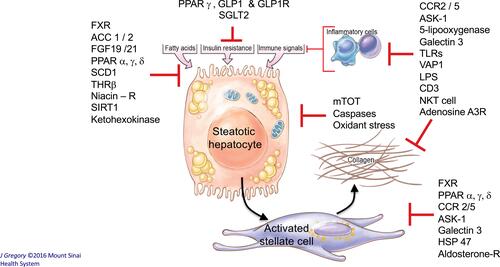Figures & data
Table 1 Summary of Therapeutic Targets and Novel Emerging Therapies
Figure 1 Key liver-related NASH targets in phase 2 and 3 clinical trials. This diagram illustrates the key cellular targets of many drugs currently in clinical trials for treatment of NASH. They include targets whose modulation is intended to reduce liver fat, improve insulin resistance and glucose homeostasis, reduce inflammation, improve mitochondrial function of hepatocytes and/or directly block fibrosis by hepatic stellate cells. Note that some targets, for example FXR and ASK-1, may contribute to responses in more than one cell type. Image illustration by Jill K Gregory, CMI. Printed with permission from Mount Sinai Health System, licensed under CC BY-NC. Ownership of original artwork, copyright, and all rights not specifically transferred herein remain the exclusive property of Mount Sinai Health System.

